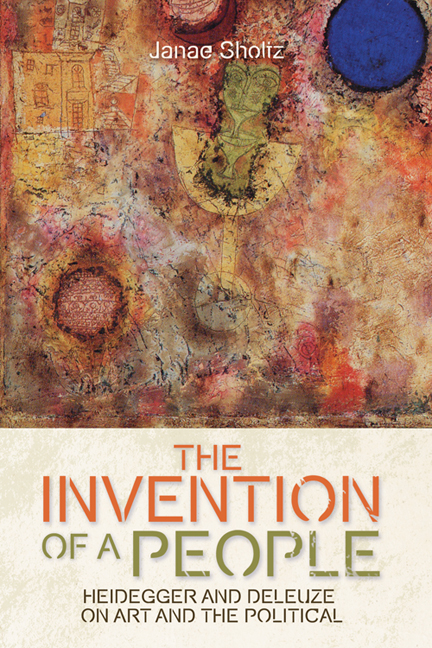Book contents
- Frontmatter
- Contents
- Acknowledgments
- Abbreviations
- Introduction: The People Are Missing
- PART I DIVERGENCE, THE POINT OF NIETZSCHE
- PART II (UN)THINKING, WHAT MUST BE THOUGHT
- PART III (UN)EARTHING A PEOPLE-TO-COME
- Introduction to Part III
- 5 Heidegger and the Political
- 6 Deleuze and the Political
- CONCLUDING EVENT
- Index
Introduction to Part III
from PART III - (UN)EARTHING A PEOPLE-TO-COME
Published online by Cambridge University Press: 05 August 2016
- Frontmatter
- Contents
- Acknowledgments
- Abbreviations
- Introduction: The People Are Missing
- PART I DIVERGENCE, THE POINT OF NIETZSCHE
- PART II (UN)THINKING, WHAT MUST BE THOUGHT
- PART III (UN)EARTHING A PEOPLE-TO-COME
- Introduction to Part III
- 5 Heidegger and the Political
- 6 Deleuze and the Political
- CONCLUDING EVENT
- Index
Summary
Through the concept of Earth a gap is sketched in being that cannot recoup, a fissure, a ‘chaos’ in the sense of chasm (béance) that opens itself in a quite diurnal manner.
For both Heidegger and Deleuze, the trope of earth as indicative of another ontological understanding, and its extension through the cosmic, is set up through considering art. At the same time, their discussions of art operate as pivotal loci for their conceptualisations of the people-to-come, a place in which the political becomes. The various topoi that each develops indicate a relation to a peopleto- come. We are not alone in thinking the political as place. De Beistegui speaks of the perpetual movements of the space of politics as dis-placement and re-placement, ‘places (Örter) of being understood as points of intensification, in which presence itself has come for a time to crystallize’, where words, things and actions come together. These final chapters follow the etchings of these topoi – earth, homeland, milieu, territory – presenting an image, however shadowy, of the political future that each envisions. We have three objectives: first, to define and interrogate Heidegger's specific sense of a people-to-come drawn from his analysis of art as a gathering place (Ort) for the historical destiny of a people which constructs the earth as homeland (Heimat); second, to combine the elements of the cosmic and the minor, which Deleuze associates with a people-tocome, into a coherent, and ultimately flexible, model of a people; and third, to further delineate the sense in which Deleuze's work is a completion and displacement of Heidegger. This final piece hinges on the fact that, though Heidegger and Deleuze both insist on this space of the unthought, their ontological dispensations determine what kind of people emerge: wanderers or nomads, which we understand as conceptual personae indicative of new paths, or images, of thought.
We claim that the earth is the centrepiece of Heidegger's later philosophy and demands another kind of thinking, what one might hazard to call a new image of thought, or perhaps a bastard reasoning.
- Type
- Chapter
- Information
- The Invention of a PeopleHeidegger and Deleuze on Art and the Political, pp. 191 - 193Publisher: Edinburgh University PressPrint publication year: 2015



